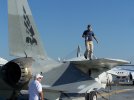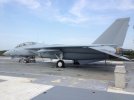So Brett sent you to stand in the corner... you should feel honored. Last dude he sent to 'time out' was the Pope!Other than that I will go face that corner Brett was talking about.

BzB
So Brett sent you to stand in the corner... you should feel honored. Last dude he sent to 'time out' was the Pope!Other than that I will go face that corner Brett was talking about.

It's all about he smoke. If only a Hornet could come out of burner and have a smoke trail like an F-4Fog, I loved the Phantom. It's a big reason I am where I am today. I stand by my statement though. You could take all of the avionics upgrades from the Rhino and put them in a F-4, and I'm still choosing the F-18.

Fog, I loved the Phantom. It's a big reason I am where I am today. I stand by my statement though. You could take all of the avionics upgrades from the Rhino and put them in a F-4, and I'm still choosing the F-18.
As Ricky Ricardo said, I'm yust yealous.
While I like the pic, both those aircraft are from the wrong coast! ;-)For Catmando:

words
Solves the problem in every aspect. On a serious side note I worked for the pilot of the C-130 that landed on the USS Forrestal and he said it was the scariest thing he did in his entire career. He had some pretty awesome stories to tell about it. Other than that I will go face that corner Brett was talking about.
"That pilot" would be Jim Flatley III ...as CAG-3 LSO in early/mid nineteen- sixties, Jim waved me aboard USS Saratoga a couple hundred times ...later was Sara's CO (1979-1981) ...then two-star ...later associated with the Yorktown exhibit at Charleston SC ...then part of an (unsuccessful) effort to convince city of Jacksonville to accept the Sara upon her decommissioning."


- There was no Internet, no email, no games, no iPods etc. To talk to family or friends back home you had to schedule a hard to get appointment or wait in a long line to call home. Phone calls on civilian lines were outrageously expensive. Phone patches worked (had to say "over" after each transmission), but were rare. Either that or send a cassette tape recording via snail mail.
- Water hours aboard ship and minimal AC in the tropics.
